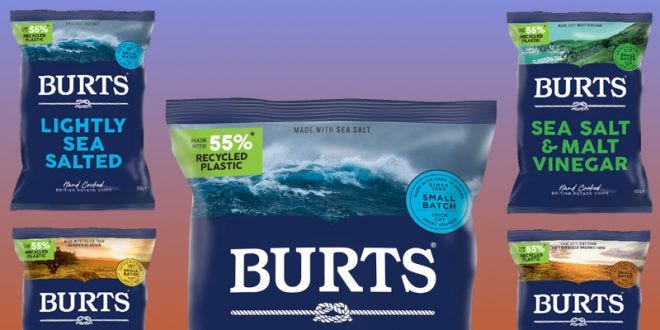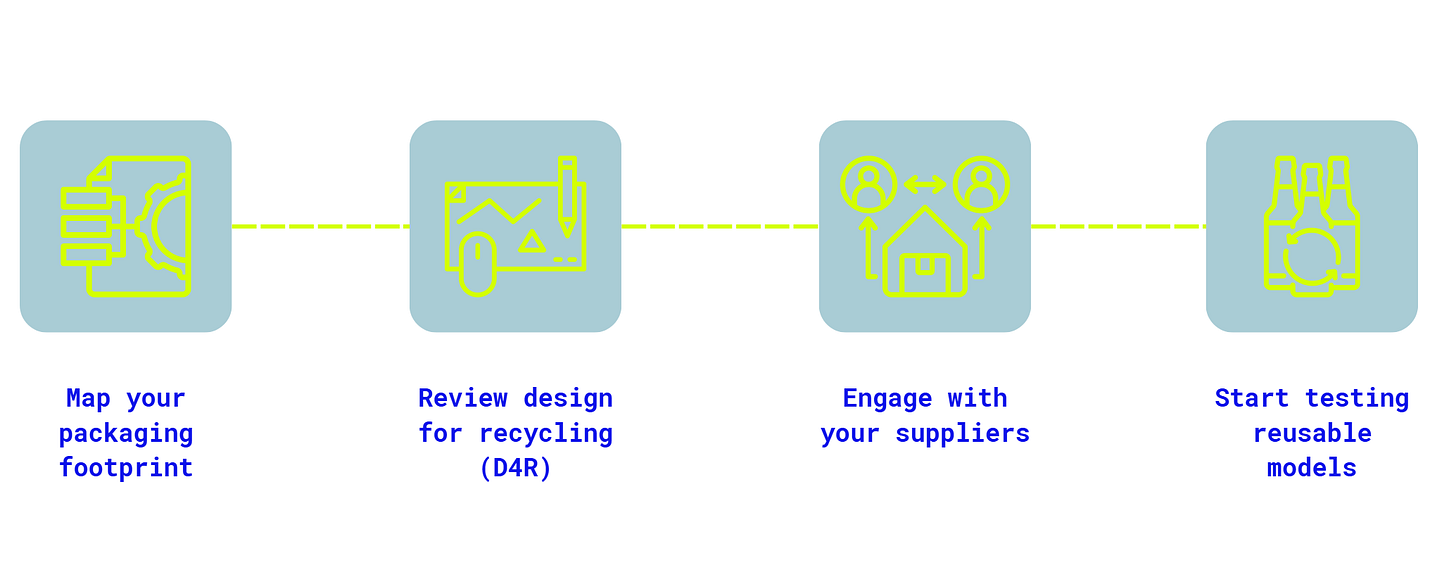📦 Regulation Watch: Packaging and Packaging Waste Regulation (PPWR)
Find out who is impacted, and what you need to do!
Every friend group has a packaging sustainability expert…right?! Well our little FTF friend and writers group does and it is 👌🙌. This week, Indira gets us up to speed on what feels like a tidal wave of incoming packaging regulation.
We’re also curious - what do you want to know about EPR? Rumour has it there’s an update in our article pipeline. I, for one, would like the topic of glass to be more transparent….Drop us a comment with your thoughts, questions, hopes and dreams!
> In Focus
Packaging and Packaging Waste Regulation (PPWR): What you need to know about the Packaging Regulation…!
Earlier this year, the EU took a significant step towards a circular economy with the formal entry into force of the Packaging and Packaging Waste Regulation (PPWR) in February 2025. While enforcement won’t begin until mid-2026, this ambitious regulation is currently on the mind of businesses, busily working to ensure their products and packaging are going to be compliant.
What is the PPWR?
It is a regulation that sits within the Circular Economy Action Plan alongside other key regulations like the Ecodesign for Sustainable Products Regulation (ESPR), helping to push for climate neutrality by 2050. The goal of this regulation is simple yet transformative: minimise packaging waste, reduce the use of primary raw materials and create a harmonised approach to circular packaging design across the EU. By targeting packaging at all stages of its life cycle - from its production phase to the end-of-life - the PPWR aims to tackle a major source of waste and pollution.
On the subject of packaging, another regulation that cannot ignored is EPR regulation, or Extended Producer Responsibility. This regulation shifts the cost burden of waste management from the public sectors to the producers, extending their responsibility to take care about the waste they have generated. Producers will pay fees based on the amount of packaging they put in the market (psst, look out for our article in the next few weeks talking about this…) meaning better packaging design will equal lower fees.
While EPR incentivises producers to reduce packaging waste through the financial pressure, the PPWR sets regulatory requirements for packaging design to ensure responsible and sustainable packaging.
Who is affected under the PPWR?
If you are a business that places packaged goods on the EU market, you are affected.
There are no general exemptions based on company size (in contrast with EPR which has certain thresholds), though some sector-specific rules exist (e.g. medical products, due to health and safety concerns). Whether you are a manufacturer, importer, distributor or an e-commerce seller, it is time to start preparing.
What does PPWR regulate?
There are lots of articles and sections covered in the regulations, with some details and calculation methodologies to be introduced by 2028, but here are some of the main elements of the regulations:
Substances of concern: Packaging that contains harmful substances, in particular PFAS (per- and polyfluoroalkyl substances, usually known as ‘forever chemicals) will be limited. This chemical is usually used in food packaging.
Recycling (D4R): By 2028, all packaging must be designed for recycling. This packaging will be assessed using the recyclability performance grades per packaging unit, accounting for how easily packaging can be sorted, separated and recycled - and this design criteria and standards is called D4R (Design for Recycling). Moreover, in 2035, not only it has to be ‘designed’ for recycling, it should also be recycled at scale, meaning it can be processed in the standard recycling systems across the EU.
Recycled content: Packaging must adhere to the binding targets for recycled content in plastic packaging.
Harmonised labelling: There will be new standardised labels to help consumers correctly sort their packaging waste, providing information on packaging’s recyclability, reusability and potentially its recycled contents. We would love to be sharing those labels with you now but it looks like the timeline on these is still a bit further out.
Reuse and refill: My favourite article - enabling packaging to be used as its intended purpose, a temporary tool for us to transport our product from purchase location, to us. This regulation sets new requirements across the beverage bottles and transport packaging, as well as putting requirements for allowing customers to refill and bringing their own containers at no extra cost for purchasing takeaway food and drinks.
Empty space limits: Ever ordered a small item online and received it in a box five times too big? Say goodbye to oversized packaging, as by 2028, ecommerce and retail packaging will be subject to strict rules capping empty space at a maximum of 50%. This also includes the use of the fillers or bubble wraps inside of the box.
So, what can you do now?
This regulation is dense and compliance will be complex - but it does not have to be if you start taking action today. Here are some few starters…
Map your packaging footprint: Understand what materials you are using, where they are sourced and where they end up. This can help you with transparency and understanding if there’s any substances of concern in your packaging.
Review design for recycling (D4R): Get ahead of the D4R by checking if your packaging can be easily separated into recycling streams! Has it been designed to be mono material, containing less glue and using less colouring? Are there any other components that can hinder its recyclability?
Engage with your suppliers: Work together with your suppliers to improve the quality of your packaging and understand how you can explain your packaging disposal process for the new labelling requirements.
Start testing reusable models: If you have invested so much for your beautiful packaging, why not extend the use cycle of those packaging before chucking it away? Particularly if you are selling beverages in glass packaging, it would be an opportunity to start testing reusable models.
No doubt you are already considering all the implications a regulation can have, it’s a complex system we are trying to improve. With that in mind, keep your eyes peeled over the next couple of years as more direction is given on this regulation.
> Follow up with…
Guide: PPWR Survival Guide
Article: What is PPWR?
> Last week in consumer goods x climate…
The Good(s) News
🎯 When in Rome announced the launch of their latest impact report, highlighting key areas such as cutting carbon footprint by 10% by moving their production location closer. They are also planning to reduce at least another 20% this year.
🎯 Swapfiets announced their latest impact report, reporting on their CO2 emissions throughout the year 2024. They also reported that across Europe, their riders saved a total of 6,460 tonnes of CO2e.
⭐️ innocent drinks and the IGD (Institute of Grocery Distribution), along with a number of charity partners, announced that they have published an open letter to launch a new campaign to improve public access to fresh fruit and vegetables. The letter calls for a collaborative approach, involving local authorities, charities, and the food industry to make nutritious foods available for all.
⭐️ Burts Snacks Ltd announced their new packaging for crisp packet made from 55% recycled plastic, which will be rolling out across a selection of its flavours and pack sizes of 40g and 150g.
⭐️ Too Good To Go announced that Morrisons have now saved over 3 million Surprise Bags through their partnership, helping Morrisons’ commitment to halving food waste by 2030.
Have good news? Share it with us - info@followingthefootprints.com!

> Bulletin Board
Jobs in CPG x Sustainability
PureFuel, [Remote, UK] Sustainability Packaging Specialist
Muller UK & Ireland, [Market Drayton, UK] Sustainability Coordinator
Events
📆 28th May: [Virtual] Forest loss in 2024: what’s at stake ahead of COP - World Resources Institute
📆 5th June: [Virtual] Perspectives Across the Supply Chain - Altruistiq
📆 11th June: [Virtual] The Business Case for Nature - UNGC
> Finally, in case you missed it…
🛒 The Check-Out: Maddy Jacobs, smol
Smol started a revolution to clean up our planet (and your kitchen counters). In the unlikely case you don’t know who they are, they focus on concentrated cleaning products delivered on a subscription model when you need them so you’re not paying for a plastic bottle filled with water (AKA cleaning products pre-smol). They’re a fan favourite of everyone…
Want more? Check out our Website! You can find more about the team behind this newsletter, dig through our content archive AND check out our handy databases there too.
Have ideas for what we should write about next? Reply to this email! We’re always looking for inspiration from folks like you.
Until next time!
Team FTF








